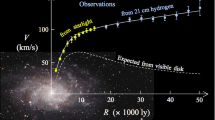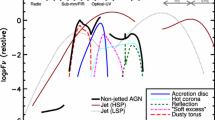Abstract
A statistical analysis of radial distributions of Luminous Red Galaxies (LRGs) from the Sloan Digital Sky Survey (SDSS DR7) catalogue within an interval 0.16≤z≤0.47 is carried out. We found that the radial distribution of ∼ 106,000 LRGs incorporates a few quasi-periodical components relatively to a variable η, dimensionless line-of-sight comoving distance calculated for the ΛCDM cosmological model. The most significant peaks of the power spectra are obtained for two close periodicities corresponding to the spatial comoving scales (135±12) h−1 Mpc and (101±6) h−1 Mpc. The latter one is dominant and consistent with the characteristic scale of the baryon acoustic oscillations. We analyse also the radial distributions of two other selected LRG samples: ∼33,400 bright LRGs (−23.2<M≤−21.8) and ∼60,300 all LRGs within a rectangle region on the sky, and show differences of the quasi-periodical features characteristic for different samples. Being confirmed the results would allow to give preference of the spatial against temporal models which could explain the quasi-periodicities discussed here. As a caveat we show that estimations of the significance levels of the peaks strongly depend on a smoothed radial function (trend) as well as characteristics of random fluctuations.







Similar content being viewed by others
References
Abazajian, K.N., et al.: Astrophys. J. Suppl. Ser. 182, 543 (2009)
Aref’eva, I.Ya., Koshelev, A.S.: J. High Energy Phys. 9, 68 (2008). arXiv:0804.3570
Arnalte-Mur, P., Labatie, A., Clerc, N., Martínez, V.J., Starck, J.-L., Lachièze-Rey, M., Saar, E., Paredes, S.: (2011). Preprint arXiv:1101.1911
Berlind, A.A., Weinberg, D.H.: Astrophys. J. 575, 587 (2002)
Blake, C., Glazebrook, K.: Astrophys. J. 594, 665 (2003)
Blake, C., et al.: Mon. Not. R. Astron. Soc. 418, 1707 (2011)
Brazier, K.T.S.: Mon. Not. R. Astron. Soc. 268, 709 (1994)
Cabré, A., Gaztañaga, E.: Mon. Not. R. Astron. Soc. 393, 1183 (2009)
Demiański, M., Doroshkevich, A., Pilipenko, S., Gottlöber, S.: Mon. Not. R. Astron. Soc. 414, 1813 (2011)
Doroshkevich, A.G., Tucker, D.L., Allam, S., Way, M.J.: Astron. Astrophys. 418, 7 (2004)
Einasto, J., et al.: Mon. Not. R. Astron. Soc. 289, 801 (1997a)
Einasto, J., Einasto, M., Frisch, P., Gottlöber, S., Müller, V., Saar, V., Starobinsky, A.A., Tucker, D.: Mon. Not. R. Astron. Soc. 289, 813 (1997b)
Einasto, J., et al.: Astron. Astrophys. 531, 75 (2011). Preprint arXiv:1012.3550
Eisenstein, D.J., Hu, W.: Astrophys. J. 496, 605 (1998)
Eisenstein, D.J., Hu, W., Tegmark, M.: Astrophys. J. Lett. 504, L57 (1998)
Eisenstein, D.J., et al.: Astrophys. J. 122, 2267 (2001)
Eisenstein, D.J., et al.: Astrophys. J. 633, 560 (2005)
Frescura, F.A.M., Engelbrecht, C.A., Frank, B.S.: Mon. Not. R. Astron. Soc. 388, 1693 (2008)
Gaztañaga, E., Cabré, A., Hui, L.: Mon. Not. R. Astron. Soc. 399, 1663 (2009)
Harrison, E.: Astrophys. J. 403, 28 (1993)
Hartnett, J.G., Hirano, K.: Astrophys. Space Sci. 318, 13 (2008)
Hirano, K., Komiya, Z.: Phys. Rev. D 82, 103513 (2010)
Hogg, D.W.: (1999). Preprint arXiv:astro-ph/9905116
Hütsi, G.: Astron. Astrophys. 449, 891 (2006)
Kazin, E.A., et al.: Astrophys. J. 710, 1444 (2010a). Preprint arXiv:0908.2598
Kazin, E.A., Blanton, M.R., Scoccimarro, R., McBride, C.K., Berlind, A.A.: Astrophys. J. 719, 1032 (2010b). Preprint arXiv:1004.2244
Kayser, R., Helbig, P., Schramm, T.: Astron. Astrophys. 318, 680 (1997)
Manera, M., et al.: (2012). Preprint arXiv:1203.6609
Martínez, V.J., Arnalte-Mur, P., Saar, E., De la Cruz, P., Pons-Bordería, M.J., Paredes, S., Fernández-Soto, A., Tempel, E.: Astrophys. J. Lett. 696, L93 (2009)
Morikawa, M.: Astrophys. J. 369, 20 (1991)
Percival, W.J., Cole, S., Eisenstein, D.J., Nichol, R.C., Peacock, J.A., Pope, A.C., Szalay, A.S.: Mon. Not. R. Astron. Soc. 381, 1053 (2007a)
Percival, W.J., et al.: Astrophys. J. 657, 51 (2007b)
Percival, W.J., et al.: Mon. Not. R. Astron. Soc. 401, 2148 (2010)
Ross, A.J., et al.: Mon. Not. R. Astron. Soc. 424, 564 (2012)
Ryabinkov, A.I., Kaminker, A.D.: Astrophys. Space Sci. 331, 79 (2011)
Sánchez, A.G., Crocce, M., Cabré, A., Baugh, C.M., Gaztañaga, E.: Mon. Not. R. Astron. Soc. 400, 1643 (2009)
Scargle, J.D.: Astrophys. J. 263, 835 (1982)
Sylos Labini, F., Vasilyev, N.L., Baryshev, Y.V., López-Corredoira, M.: Astron. Astrophys. 505, 981 (2009a)
Sylos Labini, F., Vasilyev, N.L., Baryshev, Y.V.: Astron. Astrophys. 496, 7 (2009b)
Sylos Labini, F.: 2010. Preprint arXiv:1011.4855
Tago, E., Saar, E., Einasto, J., Einasto, M., Müller, V., Andernach, H.: Astrophys. J. 123, 37 (2002)
York, D.G., et al.: Astrophys. J. 120, 1579 (2000)
Zehavi, I., et al.: Astrophys. J. 621, 22 (2005)
Acknowledgements
The work has been supported partly by the RFBR (grant No. 11-02-01018-a), by the State Program “Leading Scientific Schools of Russian Federation” (grant NSh 4035.2012.2), as well as by Ministry of Education and Science of Russian Federation (contract No. 11.G34.31.0001 and agreement No. 8409).
Author information
Authors and Affiliations
Corresponding author
Appendix: Effects of trend uncertainties
Appendix: Effects of trend uncertainties
Effects of a procedure of smoothed function (trend) determination on appropriate power spectra calculated in the binning approach. Upper panel: same radial distribution function N(η) as in Fig. 2 but with three different trends: solid line—set of parabolas (same as \(N_{\operatorname {tr}}(\eta)\) in Fig. 2), dashes—reciprocal Fourier transform employing first five harmonics, dots—radial selection function obtained from a comoving number density n(z) of Kazin et al. (2010a) with carrying out a spline interpolation. Lower panel: three power spectra calculated with using Eqs. (4), (5) and the trends displayed in the upper panel by the respective type of lines
Figure 8 demonstrates variations of the power spectra obtained with using different procedures of the radial smoothed function (trend) subtraction (see Sect. 3). We examine 105 831 LRGs from DR7-Full sample represented in Table 1 by Kazin et al. (2010a). The upper panel in Fig. 8 is designed similar to Fig. 2 but with using three different ways of the trend determination. In all cases the radial (line-of-sight) distribution function N(η) is calculated for independent bins δ η =0.00033 or c⋅δ η /H 0=1 h−1 Mpc providing narrow spike-like variations of N(η). The first trend function \(N_{\operatorname {tr}}(\eta)\) is calculated by the least-squares method with using a set of parabolas (thick solid line) as a regression function for N(η). The second one is calculated as a sum of the first five reciprocal Fourier harmonics, m=1,…,5 (thick dashed line), with full filtration of all the rest harmonics 6≤m≤40. The third trend is calculated with using the radial selection function n(z) by Kazin et al. (2010a) presented on the World Wide Web (see Sect. 1). We rescale n(z) into \(N_{\operatorname {tr}}(\eta)\) and applicate a spline interpolation for additional smoothing of the trend function (dotted line). Let us emphasize that χ 2-criterion does not admit to prefer one of three trends although the results of power spectrum calculations for each of them are qualitatively different.
The lower panel displays the respective power spectra calculated with Eqs. (4) and (5) and depicted by the same type of lines. One can see how the two most significant peaks at k=0.062 h Mpc−1 (m=8) and k=0.047 h Mpc−1 (m=6) strongly depend on a trend obtained in one of the ways indicated above: the features may variate from strong double peak (dashed line) up to its cancellation (dotted line). Whereas for k≳0.1, i.e. for shorter waves, the effects of different trends are less essential. One can notice that in the upper panel the spline interpolation of the trend (dots) displays long-wave oscillations and thus compensates the corresponding Fourier harmonics. To some degree such a compensation may occur for different trends subject to their sufficient complexity. The oscillations inherent in trends can have also as physical as nonphysical origin and in their turn need special statistical considerations.
The indicated uncertainties make the binning approach, including a procedure of the trend subtraction, quite ambiguous at least in the cases of complex trends. Therefore, one needs a verification by a few statistical tests additional to the binning approach discussed in Sect. 3, including the point-like treatment, to make more robust conclusions concerning reality of quasi-periodicities in the distribution of matter.
Rights and permissions
About this article
Cite this article
Ryabinkov, A.I., Kaurov, A.A. & Kaminker, A.D. Quasi-periodical features in the distribution of Luminous Red Galaxies. Astrophys Space Sci 344, 219–228 (2013). https://doi.org/10.1007/s10509-012-1322-0
Received:
Accepted:
Published:
Issue Date:
DOI: https://doi.org/10.1007/s10509-012-1322-0





